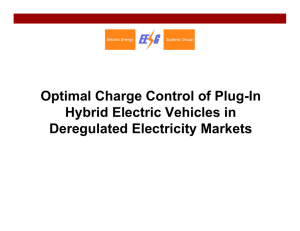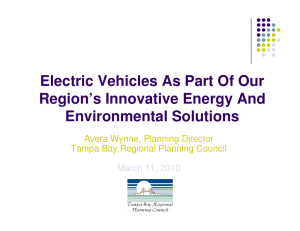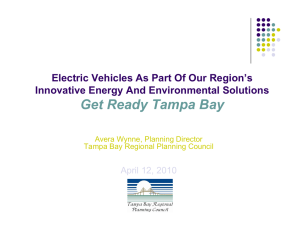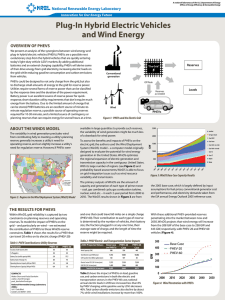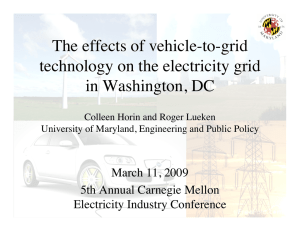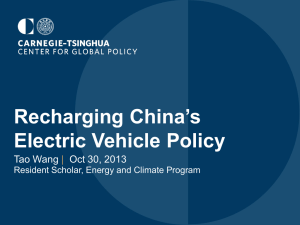Environmental Benefits of Plug-in Hybrid Electric Vehicles: the Case
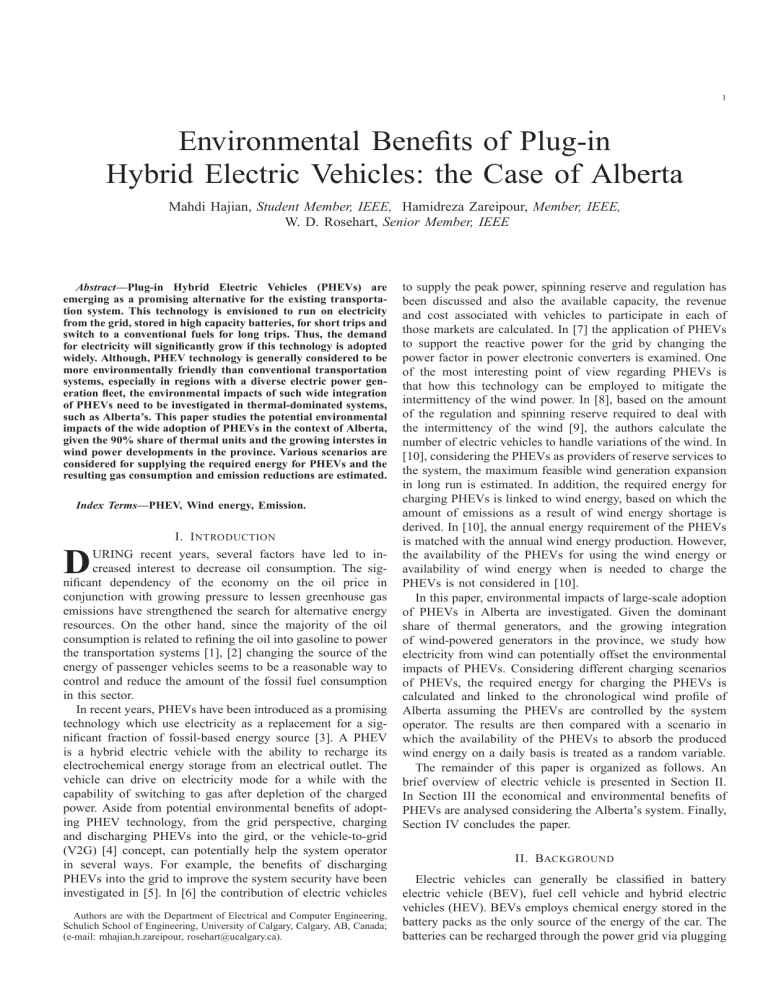
Environmental Benefits of Plug-in
Hybrid Electric Vehicles: the Case of Alberta
Mahdi Hajian, Student Member, IEEE, Hamidreza Zareipour, Member, IEEE,
W. D. Rosehart, Senior Member, IEEE
Abstract—Plug-in Hybrid Electric Vehicles (PHEVs) are emerging as a promising alternative for the existing transportation system. This technology is envisioned to run on electricity from the grid, stored in high capacity batteries, for short trips and switch to a conventional fuels for long trips. Thus, the demand for electricity will significantly grow if this technology is adopted widely. Although, PHEV technology is generally considered to be more environmentally friendly than conventional transportation systems, especially in regions with a diverse electric power generation fleet, the environmental impacts of such wide integration of PHEVs need to be investigated in thermal-dominated systems, such as Alberta’s. This paper studies the potential environmental impacts of the wide adoption of PHEVs in the context of Alberta, given the 90% share of thermal units and the growing interstes in wind power developments in the province. Various scenarios are considered for supplying the required energy for PHEVs and the resulting gas consumption and emission reductions are estimated.
Index Terms—PHEV, Wind energy, Emission.
I. I NTRODUCTION
D URING recent years, several factors have led to increased interest to decrease oil consumption. The significant dependency of the economy on the oil price in conjunction with growing pressure to lessen greenhouse gas emissions have strengthened the search for alternative energy resources. On the other hand, since the majority of the oil consumption is related to refining the oil into gasoline to power the transportation systems [1], [2] changing the source of the energy of passenger vehicles seems to be a reasonable way to control and reduce the amount of the fossil fuel consumption in this sector.
In recent years, PHEVs have been introduced as a promising technology which use electricity as a replacement for a significant fraction of fossil-based energy source [3]. A PHEV is a hybrid electric vehicle with the ability to recharge its electrochemical energy storage from an electrical outlet. The vehicle can drive on electricity mode for a while with the capability of switching to gas after depletion of the charged power. Aside from potential environmental benefits of adopting PHEV technology, from the grid perspective, charging and discharging PHEVs into the gird, or the vehicle-to-grid
(V2G) [4] concept, can potentially help the system operator in several ways. For example, the benefits of discharging
PHEVs into the grid to improve the system security have been investigated in [5]. In [6] the contribution of electric vehicles
Authors are with the Department of Electrical and Computer Engineering,
Schulich School of Engineering, University of Calgary, Calgary, AB, Canada;
(e-mail: mhajian,h.zareipour, rosehart@ucalgary.ca).
to supply the peak power, spinning reserve and regulation has been discussed and also the available capacity, the revenue and cost associated with vehicles to participate in each of those markets are calculated. In [7] the application of PHEVs to support the reactive power for the grid by changing the power factor in power electronic converters is examined. One of the most interesting point of view regarding PHEVs is that how this technology can be employed to mitigate the intermittency of the wind power. In [8], based on the amount of the regulation and spinning reserve required to deal with the intermittency of the wind [9], the authors calculate the number of electric vehicles to handle variations of the wind. In
[10], considering the PHEVs as providers of reserve services to the system, the maximum feasible wind generation expansion in long run is estimated. In addition, the required energy for charging PHEVs is linked to wind energy, based on which the amount of emissions as a result of wind energy shortage is derived. In [10], the annual energy requirement of the PHEVs is matched with the annual wind energy production. However, the availability of the PHEVs for using the wind energy or availability of wind energy when is needed to charge the
PHEVs is not considered in [10].
In this paper, environmental impacts of large-scale adoption of PHEVs in Alberta are investigated. Given the dominant share of thermal generators, and the growing integration of wind-powered generators in the province, we study how electricity from wind can potentially offset the environmental impacts of PHEVs. Considering different charging scenarios of PHEVs, the required energy for charging the PHEVs is calculated and linked to the chronological wind profile of
Alberta assuming the PHEVs are controlled by the system operator. The results are then compared with a scenario in which the availability of the PHEVs to absorb the produced wind energy on a daily basis is treated as a random variable.
The remainder of this paper is organized as follows. An brief overview of electric vehicle is presented in Section II.
In Section III the economical and environmental benefits of
PHEVs are analysed considering the Alberta’s system. Finally,
Section IV concludes the paper.
II. B ACKGROUND
Electric vehicles can generally be classified in battery electric vehicle (BEV), fuel cell vehicle and hybrid electric vehicles (HEV). BEVs employs chemical energy stored in the battery packs as the only source of the energy of the car. The batteries can be recharged through the power grid via plugging
1
2 in an electrical outlet. The main drawback of these vehicles is that their battery packs fall short of power required for large distances. A fuel cell vehicle uses a fuel cell to supply its onboard motive power by producing electricity using hydrogen fuel and oxygen from the air. This technology is usually challenged by issues such as storing sufficient amount of hydrogen, distribution of hydrogen to customers, safety of these vehicles question and their cost-effectiveness [6]. HEVs combine the benefits of gasoline engines and electric motors.
An internal combustion engine(IC) drives an electric generator whose generated power is transfered to the electric motor to drive the wheels, along with the direct shaft power from IC engine. A small battery buffers the generator and absorbs regenerative braking. The battery is also utilized to drive the electric motor during the acceleration and hill climbing to increase the fuel efficiency of the vehicle. This method of charging-discharging batteries is called charge-sustaining mode since the batteries keep a state of charge, typically 70%-
80%.
A PHEV is basically a HEV with an enlarged battery that can be recharged via an electrical outlet [6]. With externally recharged batteries, there is sufficient energy storage capacity to give the vehicle significant range on battery power alone.
Current technology of PHEV battery allows a travel distance of
20-60 miles in all electric mode of the vehicle. This strategy in which the batteries are persistently used while driving is called charge-depleting mode. Moreover, having combustion engine,
PHEVs can also use gas which makes the vehicle capable of long distance trips and even in this case with charge-sustaining mode capability the amount of the gas usage will be less than a conventional vehicle. Generally, It can be seen that combining the advantage attributes of HEVs and BEVs while alleviating the drawbacks of them, makes PHEV a potential alternative to the conventional transportation systems.
[13]. Unfortunately, this is not currently a sufficient option in Alberta considering the amount of wind developments and the fact that no local pump-storage facility exists in Alberta.
In addition, while the hydro-dominated neighboring British
Columbia can potentially play the role of ‘storage’ for Alberta, the weak tie-line interconnecting the two provinces limits this opportunity. Thus, considering the potential application of PHEVs as a distributed storage system, PHEVs could be further promoted by the regulator in the province as a tool to offset wind intermittency.
A. PHEV Economy: A Simple Analysis for Alberta
The capability of a PHEV to run at least 20 mile makes it an attractive choice for commuters. The average gas consumption in Alberta is 11.8 liter per 100 km [1], assuming 20 miles as the average travel distance of each commuter, and the average gas price of $0.8 per liter, the average cost to each commuter would be about $3/day. On the other hand, with a battery capable of storing about 8 kWh energy, a PHEV is able to travel about 20 miles [14]. Considering an efficiency of 90% for the charging system, and the average price of electricity as
6.7 cents/kWh for 2007 in Alberta [11], the approximate cost of electricity to the owner is about $0.6/day. This basically means that with a price of $0.8 per liter for gas, price of electricity needs to be at least $350 MWh to have the gas usage as economical as electricity. Assuming a 30% PHEV penetration in Alberta’s small care fleet with an average travel of 20 miles per day, with about 2,500,000 light vehicles in
Alberta [1], we would have about 750,000 PHEVs in the province. This translate into a saving of 2.8 million liters gas per day with the value of $2.2 million. It should be noted these savings will be increased as the price of gas rises or the price of electricity dropps. The above calculation does not consider the additional costs associated with purchasing a PHEV.
III. E NVIROMENTAL B ENEFITS OF PHEV S : THE C ASE OF
A LBERTA
Alberta’s electricity system currently has an installed capacity of just above 12,000 MW. From this capacity, 5893
MW is coal-fired, 4686 MW is gas-fired, 869 MW is hydro, and 497 MW is wind powered [11]. With nearly 11 GW interest in wind power developments, the Alberta Electric
System Operator (AESO) is facing an operation challenge given the thermal-dominated system with limited flexibility.
In previous years, a cap of 900 MW wind integration was in place based on AESO’s analysis on how much wind can be ‘safely’ integrated into the system. This cap was removed later in 2008. The AESO has been actively looking at ways to mitigate the high volatility of wind. For example, a pilot project for forecasting wind power was contracted but even the best obtained forecasts were not found very accurate to deal with the high wind power ramp-downs in short periods
[11]. One potential approach to deal with the intermittency of wind is to store the excess energy during high wind power generation and back up the shortage of the wind power when it is insufficient. Pump-storage hydro has been considered as a storage component to deal with wind power uncertainty [12],
B. Charging Scenarios for PHEVs
In this simulation, we only focus on charging the PHEVs and link it to wind energy production in Alberta. The 2007 wind profile in Alberta is used with a total energy production of about 1.5 TWh. Four different PHEV charging scenarios are considered, as follows:
1) PHEVs are charged during the night-time,
2) PHEVs are charged during the day-time,
3) PHEVs are charged over the all 24 hours,
4) PHEVs are charged during the night with a random availability.
In the second and third scenarios, the rush hour periods, i.e., 7:00-9:00 and 16:00-18:00, are excluded from charging times. In the forth scenario, availability of the PHEV units for absorbing the available wind energy is modeled based on a
β distribution function [15]. On a daily basis, the produced electric energy by wind and the required energy for charging the PHEVs are compared and the shortage of energy, if any is calculated. The amount of gas needed to make up for this shortage is then determined. In case of shortage of energy from the wind generators, and assuming that the shortage can
3 be covered by the coal-fired generation, the amount of CO
2 emissions are estimated, and compared with the case in which the shortage of energy is made up for by using gasoline. The factor of emissions for the gasoline and coal-fired electricity generation is assumed to be 2.4 kg per liter and 0.922 Tons per MWh respectively. In our analysis, the grid is assumed to be able to absorb the excess energy if any.
In each scenario, three different sizes of battery, i.e., 6 kWh, 12 kWh and 16 kWh, are considered which enable the
PHEV to operate solely on electricity before turning to gas and travel 20 km, 40 km, and 60 km respectively [14]. PHEV20,
PHEV40 and PHEV60 are used here to refer to PHEVs capable of running for these travel distance, respectively.
Considering the life time of the batteries, it is recommenced to have maximum 80% depth of discharge (DOD) for some kind of batteries (nickel-metal hydride batteries). Hence, in our simulation, it is assumed an 80% DOD is acceptable. For example, a PHEV20 can travel 16 miles on electric mode to keep 20% charging of its battery. For the three battery sizes, the PHEV is assumed to be fully employed up to a 80% DOD.
a 25% saving in gas when running on charge-sustaining mode is also assumed. The maximum power that limits charging of a PHEV is mainly due to the limit over the capacity of the connection to the electrical grid [10]. The maximum capacity of grid connection is assumed to be 9.6 kW (240 V @ 40 A), which can be achieved by relatively low cost of infrasturcture upgrade. The simulation results are presented below.
In addition, four wind production levels are considered in each scenarios. The first wind production level is the same as the recorded data for 2007. In addition, three other production levels, i.e., two to four times of the 2007 level, are also considered to model future wind developments (which are expected to be located in similar locations as the current windbased generation).
In the simulations present in this paper, a chronological wind profile is matched with the total PHEV energy requirement. This is to simulate instances where there is not enough wind energy to charge the PHEVs, or the produced with energy exceeds the PHEV consumption. This makes the simulations here different than those presented in several of the previous works in which the total annual production and PHEV energy requirements are compared. In addition, a smart charging system [4] in which the system operator has control over the charging of PHEVs is assumed for the first three charging-time scenarios.
1) Charging During the Night: In this Scenario, the car is charged between 18:00 and 7:00. As a result of not charging during the day, about 32% of the total wind energy, based on the 2007 wind data, would remained unused by the PHEVs.
For the base level of wind production, the total energy during the night is about 1.03 TWh. With the 4000 MWh required energy for charging PHEV20 vehicles in each day, there is about 435 GWh shortage of wind energy through the whole year. In addition, due to production of the large amount of wind energy during some nights, there is 5.1 GWh energy over the whole year which can not be absorbed by the PHEVs.
Assuming that the shortage of energy for charging the
PHEVs is compensated by using gas, the average saving in
Fig. 1.
The amount of gas saving in night-time scenario.
TABLE I
T OTAL E MISSION IN N IGHT -T IME S CENARIO (M ILLION T ONS /Y EAR )
PHEV20
2007 4 times wind 2007 wind
Energy shortage made up by 0.44
gas
Energy shortage made up by 0.4
electricity
Full reliance on conventional vehicles
1.98
0
0
2007
PHEV40
4 times wind 2007 wind
1.92
1.74
3.96
0.07
0.07
2007
PHEV60
4 times wind 2007 wind
3.4
3.08
5.94
0.59
0.59
gas consumption compared with a conventional vehicle for the different wind production levels and battery capacities are shown in Fig. 1. It can be observed from this figure that for the wind production level of 2007, a PHEV20 could save up to
80% in gas consumption comapred to a conventional vehicle.
This saving could grow to 100% if the wind production is four times as the base 2007 production level. It can also be observed from this figure that for the 2007 wind production level, a PHEV60 could only save about 20% of gas.
Table I compares the CO
2 emission resulting from using gas or electricity from coal-fired generators to make up the shortage of wind energy in charging the PHEVs. The results are presented in this table for the three types of PHEVs
(different battery sizes), and two wind production levels, i.e., the base 2007 level and four times of this base level. The results for a conventional vehicle for the same travel distance is also presented in this table. It can be observed that in the cases that the shortage of energy is compensated from using gas or electricity from coal-fired units, the total emissions are not significantly different (e.g., 0.44 versus 0.4 Million ton/year).
However, these emission levels are significantly less than the case of a conventional vehicle (e.g., 1.98 Million tons/year).
2) Charging During the Day: The charging time of vehicles in this scenario is between 9:00 and 16:00. Not charging during the rest of the time results in about 81% of total wind energy
4
Fig. 2.
The amount of gas saving in day-time scenario.
Fig. 3.
The amount of gas saving in all-time scenario.
T OTAL E MISSION IN D AY -T
TABLE II
IME S CENARIO (M ILLION T ONS /Y EAR )
2007
PHEV20
4 times wind 2007 wind
Energy shortage made up by 1.19
0.19
gas
Energy shortage made up by 1.08
electricity
Full reliance on conventional vehicles
1.98
0.36
PHEV40
2007 wind
2.68
2.42
4
2007 wind
3.96
times
1.79
1.62
PHEV60
2007 4 times wind 2007 wind
4.16
3.28
3.76
5.94
2.97
TABLE III
T OTAL E MISSION IN A LL -T IME S CENARIO (M ILLION T ONS /Y EAR )
PHEV20
2007 4 times wind 2007 wind
Energy shortage made up by 0.21
≈
0 gas
Energy shortage made up by 0.19
≈ 0 electricity
Full reliance on conventional vehicles
1.98
2007 wind
1.63
1.47
PHEV40
4
3.96
times
2007 wind
≈
≈
0
0
2007
PHEV60
4 times wind 2007 wind
3.11
0.16
2.81
5.94
0.14
not being absorbed by the PHEVs. The total wind energy during the charging time is about 288 GWh for the base level of wind production. PHEV20 vehicles are required to be charged with 4000 MWh energy in each day, so there is about 1.17 TWh shortage of the wind energy over the whole year. Assuming that the shortage of energy for charging the PHEVs is compensated by gas, the average resulting savings in gas consumption are presented in Fig. 2. Given the significantly lower wind energy production during the day, this figure shows the considerable reduction in the amount of gas saving for diffrent cases. The resulting emissions from using gas or electricity from the coal-fired units to compensate the shaortage of energy for charging the PHEVs are also presented in Table II. It can be observed from this table that the emission levels are relatively close to those of conventional vehicles in this charging scenario.
3) Charging During all 24 Hours: In this scenario, PHEVs can be charged during all 24 hours of the day except the rush
hours. About 12% of the total avaiable wind energy would not be absorbed by the PHEVs as a result of not charging during the rush hours. The total produced wind energy during this charging time is about 1.32 TWh for the base wind production level. The required energy for charging the PHEV20’s is 4000
MWh per day. This means that there is about 203 GWh shortage of wind energy over the whole year for charging the
PHEV20’s. In addition, due to the relatively high production level of wind energy during some of the days during the year, there is about 63.4 GWh energy which can not be consumed by the PHEVs. The average gas savings for this scenario are presented in Fig. 3. Comparing this figure with Fig. 1 and
Fig. 2, it can be observed that the savings in gas consumption in this scenario is close to those of the nigh charging time but significantly different than those of the day charging time.
This is mainly due to the fact that wind energy production is mostly concentrated during the night. The resulting emissions for this scenario are also presented in Table III.
4) Random Availability of PHEVs: In the first three scenarios, it was assumed that all of PHEVs are available during the charging time. However, it should be emphasized that the
PHEVs are plugged-in an electrical outlet based on the owner needs not the system operator. Therefore, the expectation that all cars are plugged-in at the start of the charging time so that the operator has control over their charging, is not always true. For considering the effects of availability of the
PHEVs to absorb the energy produced by the wind units, the first charging-time scenario, i.e., charging during the night, is repeated assuming that the plug-in time is a random variable distributed between 18:00 and 7:00. A β distribution function
[15] is used to model the plug-in time of the PHEVs, and it is assumed that the PHEV starts charging after being plugged-in
5
TABLE IV
T OTAL E MISSION IN D ISTRIBUTED TIME SCENARIO (M ILLION T ONS
/Y EAR )
3
2007
PHEV20
4 times wind 2007 wind
Energy shortage made up by 1.15
0.76
gas
Energy shortage made up by 1.04
electricity
Full reliance on conventional vehicles
1.98
0.68
PHEV40
2007 wind
2.55
2.31
4
2007 wind
3.96
times
1.95
1.76
PHEV60
2007 4 times wind 2007 wind
3.99
3.25
3.61
5.94
2.94
2.5
2
1.5
1
0.5
until it fully charges. The employed β distribution function with α = 1 .
3 and β = 4 .
5 is prsented in Fig. 4. A Monte
Carlo simulation is used to estimate the average amount of gas saving, and the resulting emission impacts, in this scenario.
As mentioned before, the available wind energy during the night for the base wind production level is 1.03 TWh, and the required energy for charging the PHEV20’s is 4000 MWh per day, and thus, there is about 435 GWh of energy shortage and
5.1 GWh of excess energy from the wind units.
Because of the random availability of the PHEVs during the night, the shortage of wind energy increases to about 1.15
TWh, and the excess energy increases to about 722 GWh. In
Fig. 5, the resulting average savings in gas consumption in this scenario is plotted. Comparing these results with those presented in Section III-B1 for the nigh-time charging with fully controllable PHEVs, it can be observed that saving in gas has decreased significantly. The resulting emissions are also presented in Table IV, which shows a significant increase in the total emissions compared to those in Table I. This characteristic is associated with the amount of wind energy that is available during the first couple of hours of the night versus the remainder of the night. The availability of the wind energy between 18:00-20:00 with respect to the wind energy during the night, for each day of the year, is plotted in Fig. 6.
On average, 31%, of the nightly wind energy is available during this block of time, therefore, introducing the variation in “plug-in time” results in decreased utilization of the wind energy to charge the PHEVs.
0
18 20 22 24
Time
2 4 6
Fig. 4. Beta distribution used to model PHEV availability for charging during the night.
Fig. 5.
The amount of gas saving in night-time scenario with distributed charging time.
80
70
60
IV. C
ONCLUSION
In this paper, potential environmental impacts of large-scale adoption of PHEVs is compared in various scenarios in the context of Alberta’s system. Chronological wind productions are linked to the required energy for charging the PHEVs.
Different battery sizes and wind production levels were studied. Four scenarios were considered for the charging-time of the PHEVs. In the first three scenarios, it was assumed that the PHEVs are fully available, and controlled by the system operator, from the beginning of their charging period. In the fourth scenario, considering a more realistic plug-in time, the availability of the PHEVs during the charging period was considered to follow a β distributed random variable. The
50
40
30
20
10
0 50 100 150
Day
200 250 300 350
Fig. 6. The percentage of the wind energy between 18:00-20:00 hours relative to the total wind energy during whole night (18:00-07:00 hours) for each day of the year.
6 shortage of wind energy, if any, was assumed to be either compensated by using gas or electricity from the coal-fired generators.
It was observed that the environmental impacts of largescale adoption of PHEVs in the transportation system in
Alberta could significantly vary depending on various factors such as charging time, battery size, and wind production level.
It was also observed that including more realistic assumptions regarding the charging process and control of the PHEVs can significantly impact the environmental benefits of this technology.
Hamidreza Zareipour (S’03, M’07) received his Bachelor (1995) and Master
(1997) degrees in Electrical Engineering from K. N. Toosi University of
Technology and Tabriz University in Iran. He worked as a lecturer at
Persian Gulf University, Bushehr, Iran, from 1997 to 2002. He received his Ph.D. degree in Electrical Engineering from the University of Waterloo,
Ontario, Canada in 2006, and he is currently an Assistant Professor with the
Department of Electrical and Computer Engineering, University of Calgary,
Calgary, Alberta, Canada. His research focuses on the economics, planning and management of power and energy systems in a deregulated electricity market environment.
R EFERENCES
[1] (2007) Statistics canada. [Online]. Available: http://www40.statcan.gc.ca
[2] J. Conti, Annual energy outlook 2007, with Projections to 2030. Energy
Information Administration, U.S. Department of Energy, washington,
DC, Feb. 2007.
[3] L. Sanna, “Driving the solution: the plug-in hybrid vehicle,” Electric
Power Research Institute (EPRI), 2005.
[4] W. Kempton and S. Letendre, “Electric vehicles as a new power source for electric utilities,” Transportation Research, Part D (Transport and
Environment), vol. 2D, no. 3, pp. 157 – 75, Sept. 1997. [Online].
Available: http://dx.doi.org/10.1016/S1361-9209(97)00001-1
[5] S. Judd and J. Overbye, “An evaluation of PHEV contributions to power system disturbances and economics,” North American Power Symposium
(NAPS), IEEE PES, Sep. 2008.
[6] W. Kempton and J. Tomic, “Vehicle-to-grid power fundamentals: calculating capacity and net revenue,” Journal of Power Sources, vol. 144, no. 1, pp. 268 – 79, Sep. 2005. [Online]. Available: http://dx.doi.org/10.1016/j.jpowsour.2004.12.025
[7] S. De Breucker, P. Jacqmaer, K. De Brabandere, J. Driesen, and
R. Belmans, “Grid power quality improvements using grid-coupled hybrid electric vehicles,” 3rd IET International Conference on Power
Electronics, Machines and Drives (PEMD 2006), pp. 505 – 9, Mar.
2006.
[8] W. Kempton and J. Tomic, “Vehicle-to-grid power implementation:
From stabilizing the grid to supporting large-scale renewable energy,”
Journal of Power Sources, vol. 144, no. 1, pp. 280 – 94, Jun. 2005.
[Online]. Available: http://dx.doi.org/10.1016/j.jpowsour.2004.12.022
[9] E. Hirst and J. Hild, “Integrating large amounts of wind energy with a small electric-power system,” Bellingham, WA and Xcel Energy, Denver,
CO, Tech. Rep., Apr. 2004.
[10] J. Short and P. Denholm, “A preliminary assessment of plug-in hybrid electric vehicles on wind energy markets,” National Renewable Energy
Labratory (NREL), U.S. Department of Energy, washington, DC, Tech.
Rep., Apr. 2006.
[11] (2009) Alberta electric system operator. [Online]. Available: http:
//www.aeso.ca/
[12] J. M. Angarita and J. G. Usaola, “Combining hydro-generation and wind energy. biddings and operation on electricity spot markets,”
Electric Power Systems Research, vol. 77, no. 5-6, pp. 393 – 400,
2007. [Online]. Available: http://dx.doi.org/10.1016/j.epsr.2006.03.019
[13] J. Garcia-Gonzalez, R. de la Muela, L. Santos, and A. Gonzalez,
“Stochastic joint optimization of wind generation and pumped-storage units in an electricity market,” IEEE Transactions on Power Systems, vol. 23, no. 2, pp. 460 – 8, May 2008. [Online]. Available: http://dx.doi.org/10.1109/TPWRS.2008.919430
[14] M. Duvall, “Advanced batteries for electric-drive vehicles,” Electric
Power Research Institute (EPRI), May 2004.
[15] A. Papoulis, Probability, Random Variables, and Stochastic Processes.
New York: McGraw-Hill, 1984.
William Rosehart received the B.Sc, M.Sc., and Ph.D. degrees in electrical engineering from the University of Waterloo, Waterloo, ON, Canada. Currently, he is a Professor with the Department of Electrical and Computer
Engineering at the University of Calgary, Calgary, AB, Canada. His main research interests are in the areas of numerical optimization techniques, power system stability, and modeling power systems in a deregulated environment.
Mahdi Hajian (Student Member 08) received the Bachelor degree in 2005 and the Master degree in 2007, both in electrical engineering, from the
Isfahan University of Technology and Sharif University of Technology, Iran.
Currently, he is a Ph.D. student at the Department of Electrical and Computer
Engineering, University of Calgary, AB, Canada. His research interests include power system operation and control within the context of deregulated electricity markets.
